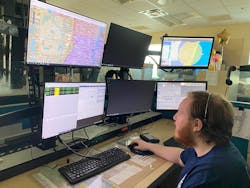This article originally appeared as the cover story in the May 2022 issue of Security Business magazine. When sharing, don’t forget to mention Security Business magazine on LinkedIn and @SecBusinessMag on Twitter.
It is a scenario nearly as old as the security industry itself: An alarm is tripped, it is routed to a central station, which eventually routes it to law enforcement, and then police, fire or EMS responds.
This scenario has remained virtually unchanged for decades, which has led to a sometimes-contentious relationship among the security industry, law enforcement, emergency response (aka 911) centers, and even the public at large.
Thankfully, the rise of data analysis, AI and deep learning is poised to dramatically change this ages-old paradigm. Through both industry-led and private company initiatives, traditional alarm monitoring and response is headed down a path to massive improvement, and many are predicting that the tangential results of these initiatives will include fewer false alarms, more effective and safer response, more apprehensions, a less combative relationship between public safety and the security industry, and ultimately, a safer country.
There are several roads down the path, but two efforts are paving the way for others to follow: The Monitoring Association (TMA) and Partnership for Priority Verified Alarm Response (PPVAR) are working together on the industry side on the new AVS-01 alarm classification standard; while ADT is leveraging its new relationship with Google to create a “smart monitoring” offering – with both having similar goals in mind.
AVS-01: Using Data to Change the Way Alarms are Classified
AVS-01 is an under-development standard that creates an “alarm scoring” or classification metric to assist law enforcement and public safety with resource allocation and prioritization of alarms. Once they are received by a central station, alarms are scored on a 0-4 scale:
- Alarm Level 0 – No Call for Service
- Alarm Level 1 – Call for Service with limited to no additional information
- Alarm Level 2 – Call for Service with confirmed or ‘highly probable’ human presence with unknown intent
- Alarm Level 3 – Call for Service with confirmed threat to property
- Alarm Level 4 – Call for Service with confirmed threat to life
“In a nutshell, AVS-01 is an intrusion alarm scoring classification standard that is going to more accurately and consistently classify intrusion alarms based on the threat level, as well as standardize how we communicate these intrusion threats to 911 centers,” explains Mark McCall, Director of Global Operations for Immix, a provider of monitoring software for central stations and security operations centers. McCall also chairs the AVS-01 Working Group for TMA.
“The value is that we will be communicating to 911 centers in a much more accurate, much more consistent process,” McCall adds, “communicating more accurate threat levels so they can better allocate resources and better respond. That really is the crux of this.”Adds Larry Folsom, SVP and Chief Monitoring Officer for ADT, who co-chairs the AVS-01 TMA Working Group: “Traditionally, we got an alarm and we treated them all the same, because essentially, they were all the same to our systems. Now, before we convey an alarm to [public safety] infrastructure, we are able to categorize the alarm data so [the 911 center] can then prioritize assets. That will lead to fewer false alarms, but that’s not the point – the point of it was the alarm can be put into one of these categories that helps them understand that [a particular] alarm has more information and potentially a higher risk to life.”
David Holl, Director of Public Safety at Lower Allen Township, is also a co-chair of the TMA Working Group, representing the public safety/response portion of the equation. With more than 40 years in alarm response under his belt, Holl has seen, heard and directed response to thousands upon thousands of alarms.
“It has always been that when you get an alarm, it is coming from a black hole – you didn’t know how it got there, you didn’t know what caused it, you didn’t know what the parameters were…you just knew you had a house or a business to go to where there was an alarm event,” Holl explains.
“The collaboration here between the alarm industry and public safety has been a paradigm shift and a game-changer, and I think it is just the very beginning of a relationship that will add value to both worlds,” Holl adds. “It will make officers safer when they respond, provide better information, and make the job of a telecommunicator so much easier by changing how information is received, exchanged and relayed.”
Analysis of Alarm Data
Folsom goes on the explain that a “1” on the scale is what we would consider “a traditional alarm” – not unlike the scenario at the beginning of this article. What is interesting is that in crafting the levels of alarm classification, TMA members – ADT included – submitted data from thousands of alarm scenarios.
“The statistics from the alarm data that were collected show that our mothers were right – nothing good happens in a business from 11 p.m. to four in the morning,” Folsom says. “At first, we looked at a [level 2 alarm] only being proof of a person, but [the data enabled us to] add to level 2, so if it is after hours at a business, and we have an alarm event, statistics have shown us that is not like a regular (level 1) alarm.”
McCall is careful to point out that the intent of the AVS-01 standard is not “alarm verification” – which has its own connotations in the security industry. That said, to get to a level 3 or 4, there must be some form of confirmation of threat/danger to property or personal safety, just not necessarily via video or audio.“The intent of the standard is to try to push toward more data about [alarm events] that indicate a human presence or an actual threat to a person or property – just more accurate information,” McCall says.
Folsom explains another example of how actual alarm data can contribute to the definition of a level: “It seems counterintuitive as alarm people, but we found that that a multiple-zone alarm does not necessarily mean an actual [intrusion]; in fact, it turns out that half of the actual [intrusions] contributed were [tripped by only] one zone.”
When it comes to false alarm reduction, the Working Group believes again that while it is not “the intent of the standard,” it would be a logical byproduct. “[The alarm levels] will become more refined and more accurate over time as companies invest the time and the resources into better data analytics,” McCall says. “As time goes on and with more accurate reporting, it will drive innovation to get a more accurate response and a push toward more [level] zero alarms, where there is no call to 911.
“There’s absolutely no question that we have to reduce the number of calls for service, or make sure the data that we send to 911 centers (or ECCs) is more accurate,” McCall continues. “We have a duty to our customers to respond to alarms, so we can’t just begin not responding to alarms, but we can pass on better information. I want to make sure we are not confusing false alarm reduction with this standard, but as we classify and report on what we are we doing as part of this standard, we will see additional focus on false calls for service and ultimately help reduce those calls. That’s longer-term, but it is certainly a byproduct of the standard.”
AVS-01’s Progress and Eventual Adoption
AVS-01 is still in the early stages. The Working Group is finalizing the language of the standard and will open it very soon to a “preliminary review” phase, where TMA, PPVAR and other industry and public safety stakeholders will have an opportunity to review, comment and ultimately, revise the standard. From there, the standard will be submitted to the American National Standards Institute (ANSI), where it will be subject to a 30-day public comment period.
“In parallel to creating the standard, PPVAR and TMA are jointly working together to get this out in front of not just our industry, but also to make sure that the public safety community knows what’s coming, because they will begin to hear different terminology,” McCall says. “They need a clear understanding what those [alarm level] definitions are, and then what an appropriate response is based on their interpretations of those alarm levels. There’s nothing in the standard that dictates how the public safety industry should respond, but the desire is once they start hearing a consistent message and they began to trust what they are hearing, they will adapt accordingly.”
Upon its adoption, AVS-01 will be a central station standard and will be an extra classification from UL; thus, any UL-listed central station will need to be compliant.
“As this becomes adopted and a more recognized and established standard, you will see pressure for central stations to adopt it,” McCall says. “I think we will see pressure from public safety, which will be looking for this type of information from central stations. We cannot demand it, but we certainly can say that this is the preferred method of communication [of alarm events] from central stations.”
ADT and Google: Where AI and Monitoring Meet?
With its newly unveiled and released SMART Monitoring offering, ADT is bringing the power of Artificial Intelligence and Google Analytics to its alarm monitoring, to facilitate faster, prioritized response using enhanced verification methods that go beyond a typical phone call.
SMART stands for System Monitoring and Response Technology. One of the services within the ADT SMART platform is Alarm Messenger,The user and their call list can see what caused the alarm, collaborate via chat, and make informed decisions to cancel the alarm or request service from public safety.
“An interesting statistic is about 70% of outbound calls from industry monitoring centers go unanswered. People no longer answer a call if they do not recognize the number, so texts make more sense for communicating urgent messages today,” Folsom says. “Last year, we went from about 100,000 customers [using Alarm Messenger] to 3.4 million customers in one year. It is actually the fastest adoption of monitoring technology in the history of the industry.”
As evidenced by its adoption at the company, text messaging alarm verification features are becoming more common among home alarm vendors; in fact, ADT says Alarm Messenger has already resulted in a 54% reduction in false alarms, which Folsom says translates into 1.8 million suppressed false alarms to date. ADT processes approximately one million alarms on a monthly basis.
Another key service as part of the monitoring platform is “ADT Next Generation 911.” This service provides what Folsom calls “the last mile” – connecting a requested alarm dispatch to a 911 center.
“We basically built upon our architecture and hosted a set of message brokers in Google Cloud so that when an alarm event is processed, instead of making a phone call, it outputs the alarm event electronically to 911 via the ADT Next Generation 911 service,” Folsom explains. “A traditional outbound call takes about 100 seconds; this electronic alarm delivery process takes 12 seconds, when every second counts.”
The system leverages alarm verification technology that Folsom brought when his company, I-View Now, was acquired by ADT in 2019. He says they rebuilt it from the ground up when ADT began working with Google in the middle of 2020. Once users opt-in and allow the monitoring center access to video and audio assets, the system can process alarm events and associated multimedia simultaneously, and score the event for prioritization.
“As the security system begins to communicate with ADT, we kick off a set of services (the SMART platform), where we begin communicating with Google and encrypt that data,” Folsom explains. “We fetch data from multiple sources, sensors and smart devices like video cameras, and then we basically take the Google library of thousands of different video and audio analytics to validate [the alarm].”
Essentially, this gives first responders the same sort of actionable classification of an alarm and its severity – in much the same way as AVS-01 – and ADT believes it will decrease response time in an emergency.
What it All Means for Integrators
Why does this matter to residential and commercial integrators? For one, working with an AVS-01 certified central monitoring partner will help ensure prioritized response to emergencies while curbing potential false alarms (and fines) – which is certainly a marketable benefit.
“For the [integrators] who sell services and products that meet the [AVS-01] standard, customers are going to get a higher priority response in an emergency,” Folsom says. “Integrators can earnestly sit with a customer – regardless of your company – and be able to explain how this gear and service is going to fall into specific categories of response based on the standard, and we have never had that before. The great benefit to [integrators] is the ability to differentiate and to sell specific services to help make their customer safer.”
Paul Rothman is Editor-in-Chief of Security Business magazine. Access the current issue, full archives and apply for a free subscription at www.securitybusinessmag.com.








